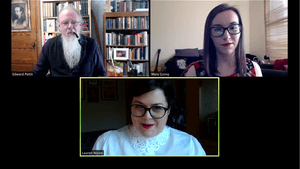Stay in the Loop
BSR publishes on a weekly schedule, with an email newsletter every Wednesday and Thursday morning. There’s no paywall, and subscribing is always free.
If you stream it, will they come?
Seven tips for transforming in-person conferences into irresistible online experiences

We’re event geeks. We’ve enjoyed every flavor of gathering, from super-structured corporate assemblies to community-built unconferences to brazenly creative festivals and everything in between (bonus points for amazing breakfast spreads). And Philly hosts many great happenings throughout the year, including Drexel’s Philly Chef Conference, the Fringe Festival, BarCamp Philly, and the Pennsylvania Conference for Women.
As many conferences transform their in-person event programming into virtual opportunities for the near and distant future, we’re sharing our strategies for making an inclusive, engaging, and innovative virtual experience. As conference organizers, attendees, and presenters, we’ve seen everything from the best to the truly underwhelming (here’s Marta’s take on creating more inclusive conferences). And these tips don’t expire with the pandemic: they’re good for in-person events too, when the world gets back on track.
Set the mood with your favorite breakfast sandwich (let Neil be your guide), and let’s dive in.
Offer authentic engagement
Your audience has an incredible range of options when it comes to spending time, money, and attention. Why should people attend your event? Are you putting something online just to have something on offer? Or are you creating with your values and theirs in mind? The answers to these questions will guide your planning process. It behooves you to reconsider the financial structure of your gathering: attendees’ money situations may have changed, and the costs of the events themselves have as well (unless you’re still buying everybody breakfast). More groups than ever are running pay-what-you-can or similar models.
Hire a virtual conference producer
Bad things happen when your presenters also have to manage event attendees. Save yourself a headache and hire someone (or appoint a member of your event-planning committee) to be the person who helps participants struggling with the conference technology, advances the speaker’s slide deck, moderates the Q&A session, and boots out anyone causing a disruption onscreen or in the chatbox.

Balancing these tasks may even take multiple teammates, so have conversations with your team early on about who feels comfortable using the technology and could step in if the producer needs assistance. If several participants decide to Zoombomb your event at the same time, or if the speaker’s feed drops out and the producer needs to work with them to reconnect, having tech-savvy team members swoop in (and possibly tell jokes to lighten the mood when issues arise) will keep things moving. Teamwork makes the dream work, especially during virtual events.
Make events shorter and spread them out
Before COVID-19 canceled everything, in-person conferences needed to cram as many panels, presentations, and networking events into as little time as possible. We don’t need to do that with virtual conferences, and nor should we—the human body was not meant to watch webinars for eight hours straight.
Spreading your conference’s events out over several days or weeks is not only a big plus for your Zoom-weary audience; it also means you have more time to invite extraordinary panelists and special guests. The Rosenbach’s virtual Sundays with Dracula series invites attendees to a weekly reading and conversation about the classic novel with public programs manager Edward G. Pettit and a revolving series of guest cohosts, including Bram Stoker’s great-grand-nephew Dacre Stoker (a writer himself), British PhD candidates-turned-Buffy and the Bible conference organizers Mary Going and Lauren Nixon, local actor and playwright Josh Hitchens, and The Southern Book Club’s Guide to Slaying Vampires author Grady Hendrix.
Start. Events. Later.
No one wants to be online before 10am anymore. Scheduling your web gathering at lunchtime or in the evening gives folks who are working from home a chance to switch gears and relax, which increases the likelihood that your event will resonate with participants. The Freelance Focus series by Alex Hillman of Indy Hall and freelance event producer Catherine Sontag hosts a different lunchtime event each week with guest instructors such as marketer Janelle Allen and Dr. Hava Rose, creator of The Write Echo Podcast. Philadelphia Magazine’s ThinkFest, which will host its programming June 8 through 12, also follows the late-start model, with presentations and panels at noon and 4pm each day.
At the same time, have a sense of how your event fits into your audience’s day. Listening to a concert or a book reading may be preferred over attending a panel discussion as a way to wind down in the evening, for example.
Foster an inclusive environment
Remember that people may be splitting their attention between the presentation and their inbox, their computer, and their household, or otherwise unable to view what’s onscreen due to visual impairment or blindness. Build multiple modalities of interaction: if there are slides, presenters should describe the images on them for those listening (and, before that, design them so they;re visually meaningful to those watching). Your virtual conference producer can guide participants in accessing recordings and other resources and in using chat rooms and other functions during the event.
Bear in mind differences in bandwidth as well. Not every participant may have the capacity to share their own video or audio. Lag and glitches due to busy wireless networks are rampant. Depending on the event, it may make sense to have a backup speaker or activity in case a technical catastrophe strikes.
Plant seeds for relationship-building before, during, and after
Nothing will replace the theater lobby, the coffee urns at the conference, or the kitchen of the house party. In a virtual setting, attendees may crave interpersonal interactions more than ever, so give people the opportunity to connect outside of the conference program itself. How do you create space without forcing interactivity into a particular space and time? This will add authenticity and foster organic engagement. Participants will want to take part and see a value, a shared experience, beyond the ticket price.

Several ongoing virtual meetups bear this out. Fans of the Rosenbach’s weekly Dracula series are also invited to continue the conversation on the companion “Sundays with Dracula” Facebook group, where Pettit and others post pictures of their Dracula memorabilia and musings on the most famous vampire in literature. The Philadelphia Asian Performing Artists (PAPA) collective has designated “Office Hour” chats for members to converse with PAPA organizers. Blue Stoop has started “Wednesdays on the Stoop” sessions for writers to connect as peers.
Explore new ways to use the medium and have fun!
We know that this transition has created challenges and opportunities for many creators. We also know that, regardless of the platform, events done right take a lot of time and work. But we’ve entered a period of creativity and curiosity, where folks are fearlessly trying new hobbies and venturing into spaces that were previously unavailable to them, perhaps because there was no time to attend them or due to distance. Now we’re seeing virtual cooking classes, book clubs, improv performances, writers’ meetings, and even burlesque shows. The Free Library’s Culinary Literacy Center teams up this month with drag queen Lili St Queer to teach cocktail-making and LGBTQ history. And don’t forget ways to engage with audiences beyond screens! The fatigue is real.
As our region’s experience-makers grow into new settings, we all have the chance to make a larger splash on a global scale, especially if we take the time to truly build with attendees’ varying needs in mind. Philadelphia began as the Holy Experiment under William Penn, and during the COVID-19 pandemic, we’re continuing to show our grit and creativity.
Sign up for our newsletter
All of the week's new articles, all in one place. Sign up for the free weekly BSR newsletters, and don't miss a conversation.

 Neil Bardhan
Neil Bardhan
 Marta Rusek
Marta Rusek